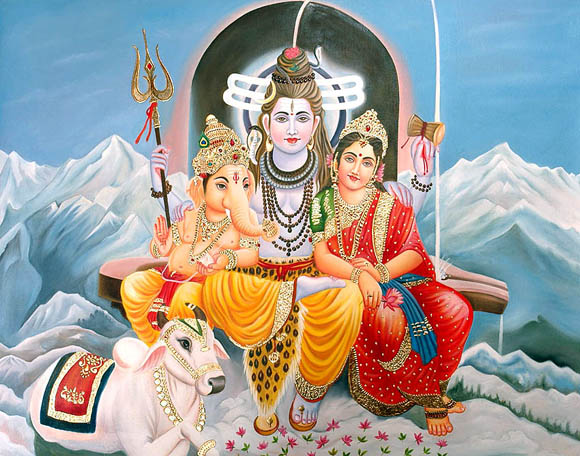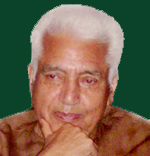Shivaratri The greatest Festival of Kashmiri Pandits
|
|
|
|
|
|
 Close to heart Close to heart For centuries, Hindus of Kashmir have been observing Shivaratri with utmost zeal and devotion. And the age-old traditions with its elaborate rituals covering three-fourth of the dark half of the lunar month of Phalguna (Feb-March) are followed even to this day, modified, of course, to suit the changing times and circumstances. The 21-day celebrations are marked by the same excitement, exultation and euphoria as in the days of yore. The way our displaced and uprooted brethren have been observing Shivaratri in tents and makeshift tenements for the last 20 years shows how close this festival is to our hearts. Keeping in view its length and religious-cum-social over-tones, it may be compared to Durga Puja and Ganapati festivals celebrated with equal devotion and enthusiasm by the Hindus of Bengal and Maharashtra respectively. Also called Hayrath-Why? In Kashmir, Shivaratri is also called Hayrath, which is the corrupt form of hairat, a Persian word meaning 'utter surprise'. The term, Hayrath, was coined during the Pathan rule in the valley. As the story goes, the Pathan governor of Kashmir, Jabaar Khan by name, forbade Kashmiri Pandits from celebrating Shivaratri festival in winter in the lunar month of Phalgun (Feb-March). Instead, the tyrannical ruler forced them to celebrate it in the hottest month of Aashaadh (June-July). The perverted ruler knew that heavy snowfall always marked the great event as is evident from the following refrain of a song usually sung at Shivaratri time: Suna sheen volun daari daare: Maharaza raaza kumaar hai aav (Flakes of gold snowed slow and steady when prince Shiva arrived to marry princess Uma!). The helpless people obeyed, but Lo' and behold, snow did fall in July that year! The miracle startled everyone, the Pathan ruler, in particular, who expressed utter surprise, Hairat. Hence the new name for Shivaratri celebrations. Since the untimely snowfall resulted in crop failure and famine, the people of the valley faced untold misery. The forced alteration in the timing of the festival, therefore, brought innumerable curses upon the ruler. The people cried out in despair: Wuchton Yi Jabbaar Jandah, Haaras Ti Kurun Wandah! (Look at this wretched Jabaar in rags; he turned summer into winter!). Shiva Chaturdashi As Hindus all over India and elsewhere in the world observe Shivaratri on the 14th day of the dark fortnight of the lunar month of Phalgun, a day after its observance by their counterparts in Kashmir, it is also known as Shiva Chaturdashi. It is believed that Lord Shiva, the 'King of Yogis' and the 'Destroyer-Renovator of the Holy Trinity', manifested on earth on this day to redeem his devotees. The Hindus of all castes and creeds observe fast, offer prayers and spend the whole night in worship of Lord Shiva in homes and temples. However, Kashmiri Pandits too observe Shiva Chaturdashi, not in the lunar month of Phalgun like the Hindus elsewhere but a month earlier in the dark fortnight of the lunar month of Magha (Jan-Feb), when they keep, not just a day’s fast, but a 3-day fast, and worship Shiva with great devotion. They even avoid non-vegetarian preparations in their homes on these days.
Puja and its significance Preliminary Preparations Dunya Mavas A: Ram Bror (name of the person); Q: kya heth? (What have you brought?) ; A: anna heth, dhana heth (food, wealth etc). How romantic and fascinating! PRASAD After the final and concluding puja on Dunya Mavas, the soaked walnuts and tumul chut (rice-cakes) are distributed as the main prasad among the family members, friends and close relatives. The use of dried walnuts for both worship and prasad is something very unique in the observance of Shivaratri by the people of Kashmir. Possibly, it has some symbolic purpose inasmuch as dried seeds when soaked pave the way for renewal of life from objects that are supposed to be dead. The process of distribution of prasad continues for a week till Teela Atham, the 8th day of the bright half of Phalguna when Hayrath celebratiions formally come to a close. In good old days back home, a lighted earthen lamp would be placed on ari (seat made of grass) and allowed to float in the river (reminiscent of a similar scene in the evenings at the holy Ganges in Haridwar). On this day of glee and charm, the children used to have had the last laugh. They would burn unserviceable kangris (fire-pots) in the evenings, mostly on the banks of river Jehlum. Known as jatun tuun, in our native language, the festivity was symbolic of the end of severe winter in Kashmir, very much similar to the festival of Lohri in Punjab. Social Aspect Shivaratri provides a wonderful and meaningful get-together for all members of the family. Every member of the household is normally in a festive mood. It is a day of prayer and meditation for the elders and one of fun and frolic for the youngsters, particularly children in their new colorful attires. During the entire period of the 3-week celebrations, all the family members, men, women and children would play with cowries (sea shells). One and all used to enjoy this fun-filled indoor sport, known as haara-baaz. It is customary for the women-folk, the old and young alike, to visit their malyun (parental home) and return to their varyuv (in-laws) with atagat (money in token of love) and kangri (fire-pot), considered to be a good omen on this occasion. The newly-wed girls would normally return from their paternal homes on the eve of the main Shivaratri function, preferably on the 10th day (dhyara daham), bringing with them, what in Kashmiri we call, hayrach bhog (Shivaratri shagun) in kind and cash. In the days gone by, it used to be a challenging time for some in the event of their Hayrach Bogh falling short of the expectations of their mothers-in-law. The proverbial mother-in-law (not uncommon, perhaps, even now) would heave cold sighs, beat their foreheads and curse their luck. Karma Khandit Asam, they would say. Salaam The day after Maha Shivaratri Puja is called salaam, a Persian word for greeting. It is a day of fun and feasting, a sort of Thanksgiving Day when relations, friends and colleagues would exchange greetings. The singing bards and the poor would visit Hindu homes and take their share of Shivaratri presents in cash or kind or both as the case may be. Hayrath Kharch On Shivaratri day, the head of the family offers pocket money to children and other younger members in the family, including the new brides, sons-in-law and the newly wed daughters. Called hayrath kharch, it is also sent to nearest relations, including their newborns and newly married children. Spirit Of Shivaratri Though Kashmiri Pandits have now migrated en-masse, at the point of gun out of their homes and hearths in Kashmir, the spirit of Shivaratri continues to be still observed, celebrated and contemplated upon in many foreign lands today. This occasion keeps alive the very essence of Shiva and the eternal values He embodies, i.e. mutual love, togetherness, open mindedness, inclusiveness and respect for one and all. No wonder, each year Shivaratri becomes the time for new beginnings ~ when old wounds are forgotten and new relationships fostered! May the spirit of Shivaratri awaken the spirit of Shiva in each and every one of us! |
|
|
|
After retiring from Indian Information Service (I.I.S.) in 1983 where he distinguished himself as an editor, correspondent, commentator and administrator in All India Radio, he edited, AICC Journal, Varnika, (Jan.'84-Dec.'90), Koshur Samachar (March'91-Oct '95, Sanatana Sandesh,(1997-2005) and KASHEER (2003-2004), He has been writing profusely on various aspects of Hindu thought. He enjoys writing, particularly on saints and sages, not only of Kashmir, but of the other parts of India as well. Presently he lives in Miami, and spends his time writing personal memoirs. |
|
|
| Copyrights © 2007 Shehjar online and KashmirGroup.com. Any content, including but not limited to text, software, music, sound, photographs, video, graphics or other material contained may not be modified, copied, reproduced, republished, uploaded, posted, or distributed in any form or context without written permission. Terms & Conditions. The views expressed are solely the author's and not necessarily the views of Shehjar or its owners. Content and posts from such authors are provided "AS IS", with no warranties, and confer no rights. The material and information provided iare for general information only and should not, in any respect, be relied on as professional advice. Neither Shehjar.kashmirgroup.com nor kashmirgroup.com represent or endorse the accuracy or reliability of any advice, opinion, statement, or other information displayed, uploaded, or distributed through the Service by any user, information provider or any other person or entity. You acknowledge that any reliance upon any such opinion, advice, statement, memorandum, or information shall be at your sole risk. |


 Prior to the start of puja on the main day, Trayodashi, several pots, representing various deities, including the two larger vessels signifying Shiva and Parvati, are embellished with flower garlands tied round their mouths and dried walnuts deposited in them nearly to the brim. The smaller vessels, representing other deities, are similarly readied for formal worship. A couple of more vessels are also kept ready for lesser deities like the Bhairavas.
Prior to the start of puja on the main day, Trayodashi, several pots, representing various deities, including the two larger vessels signifying Shiva and Parvati, are embellished with flower garlands tied round their mouths and dried walnuts deposited in them nearly to the brim. The smaller vessels, representing other deities, are similarly readied for formal worship. A couple of more vessels are also kept ready for lesser deities like the Bhairavas.  A journalist by profession, a scholar by temperament and a writer by choice, Gopinath Raina was inclined to the study of religion from his very young age. It was Swami Vivekananda’s dynamic exposition of Hindu thought that fired his imagination while he was still at school, and by the time he entered college, he had been drawn to the writings of Gandhi, Aurobindo, Narayana Guru, Radhakrishnan and Bertrand Russel.
A journalist by profession, a scholar by temperament and a writer by choice, Gopinath Raina was inclined to the study of religion from his very young age. It was Swami Vivekananda’s dynamic exposition of Hindu thought that fired his imagination while he was still at school, and by the time he entered college, he had been drawn to the writings of Gandhi, Aurobindo, Narayana Guru, Radhakrishnan and Bertrand Russel.